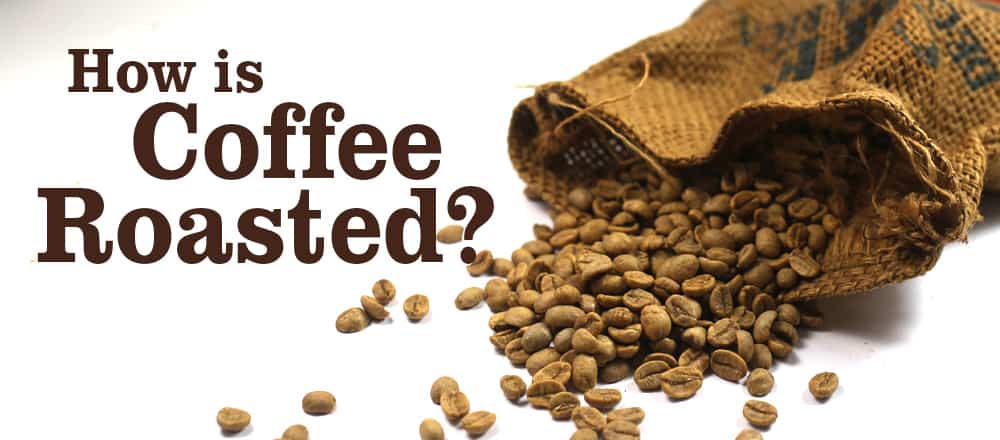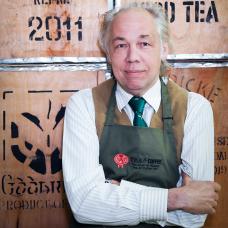How is Coffee Roasted?

How is Coffee roasted? It’s a journey of sorts, one that uses state-of-the-art technology, as well as the care and diligence of individual workers. Roasting is arguably one of the most crucial stages of the Coffee process.
Indeed, from plant to cup, nothing quite defines one’s morning brew more than roasting. In this blog, you will find out exactly why and how.
Once you know the facts, you can try one (or more!) of our 70 types of coffee. Whether it’s Single Origin or a Coffee blend; an Espresso or even Flavoured Coffee, we have a beverage for you.
The Kent and Sussex Tea and Coffee Company pack every Coffee, Loose Tea and Tisane fresh to order. This ensures not only quality but also consistency.
Table of contents

What Happens Before Coffee is Roasting?
Coffee begins life not as a bean, but a seed of the Coffea plant. There are two main types: Coffea arabica and Coffea canephora. These, in turn, produce two varieties of Coffee: Arabica and Robusta, respectively. The former accounts for around 75% of worldwide consumption while the latter amounts to approximately 25%.
The first stage of the Coffee Process is harvesting, which usually takes place in the dry season. This is when the Coffee ‘cherries’, as they’re known, are at their firmest, glossiest and of the brightest red colour.
In Brazil, the dry season is typically from May to September, while in Central America, it’s from October to March. In Africa, meanwhile, it’s from October to April, and in Asia, it begins from November and ends in April.
The beans within these cherries must be processed promptly after harvesting to avoid spoilage. One of the first primary steps is to strip the bean of its outer pulp and skin. There are two ways to do this: the “washed” method and the “unwashed” method.
Once this is complete, the green Coffee beans must be graded according to several criteria. This includes, but is not limited to: country of origin, specific regions or estates, growing altitudes and washed/unwashed processing.
Most Coffee beans remain unroasted when they’re exported. For the most, it’s up to the distributors to decide the roasting specifications once they arrive at their destination. All that is left, then, is to do one last quality control check before the roasting can begin.

How is Coffee Roasted?
Green Coffee beans must undergo roasting to be consumable in brew-form. Before this happens, they bear little resemblance to their roasted counterparts. Instead, these beans are soft and spongy when bitten, and smell somewhat grassy. Ultimately, this essential stage in the Coffee Process brings out the flavour and aroma locked within. But what are the requirements for this?
A natural chemical change takes place when Coffee reaches high temperatures. Knowing when this change becomes the desired roast, however, requires years of expertise. Individual Coffee roasters must have the ability to “read” the beans, which often means making split-second decisions. Depending on this timing, the type of roast will differ significantly.
Here at The Kent and Sussex Tea and Coffee Company, we have four roasting styles: “Light-Medium”, “Medium”, “Medium-Dark” and “Dark”.
Each kind has something unique to offer. Each kind must also be created at a specific time during roasting. We use the Neuhaus Neotec fluidised air-bed system, which uses convection heat transfer to roast the Coffee to these specifications:

Coffee Roasting Specifications
Medium-Light Roast
Often, determining the type of roast applied to the beans is as easy as looking at its colour. As the name suggests, a Medium-Light Roast is relatively light in appearance, typically with a pale-brown colour. More important, however, is the fact that this type of roast absorbs heat for the shortest time.
Coffee beans pop, crack and expand when under heats between 350°F – 400°F (177°C – 200°C). This phenomenon has become known as the “first crack”. As a rule of thumb, lighter roasts are seldom roasted beyond the first crack. Ultimately, it creates an earthy, grainy, acidic taste with occasional sweet notes.
Medium Roast
Following the first crack but before the “second crack” is where a Medium Roasted Coffee lies. This takes place under heats between 410°F – 430°F (210°C – 221°C). Most consider a Medium roast the most common type available. When brewed, they boast well-balanced, less-acidic tastes with a distinct smoothness.
Medium-Dark Roast
This roast is the product of heating the beans between 435°F – 445°F (223°C – 229°C). It coincides with the middle of the second crack, which brings about moderate oil formation on the surface. Typically, Medium Dark Roasted Coffees have a rich flavour with bittersweet notes. The beans likewise lose some of their acidity.
Dark Roast
This is arguably the second most common roast after medium. Beans that have reached heats between 465°F – 485°F (240°C – 251°C) tend to lack the acidity of their counterparts. This mostly happens by the end of the second crack, sometimes beyond. They’re shinier and oilier on the surface and, of course, darker in colour. A good example of a dark roasted coffee is our Italian Coffee Beans

What Happens After Roasting?
Once the roasting is complete, the beans are promptly cooled. At this point, the Coffee smells unmistakably like, well, Coffee! The beans also weigh less owing to reductions in moisture, and are notably crunchy when bitten. Next comes the grinding, which exposes the beans’ interior, thus allowing extraction of the right amount of oils and flavours.
Some customers choose to do this at home by purchasing Coffee Beans. Others buy ready-ground Coffees. Whatever your preference, we can accommodate your needs.
Here at The Kent and Sussex Tea and Coffee Company, we have three grind specifications. These are “Ground Espresso Fine”, “Ground Medium Fine” and “Ground Cafetiere Coarse”.

The Coffee Process begins with harvesting, then washed/unwashed preparation, then grading and exportation. Once it arrives at its destination, the beans undergo a chemical change better known as roasting.
Distinctions in the taste of Coffee are influenced significantly by how long the beans are heated. Choices vary from Medium-Light to Dark roast.
After roasting, the next stages are grinding and, ultimately, distribution. For this, be sure to choose The Kent and Sussex Tea and Coffee Company.
Why not browse through our vast range of Coffee (and, of course, Tea!) products online or in-store today?

 Loose Leaf Tea
Loose Leaf Tea Pyramids
Pyramids Tea Bags
Tea Bags Africa
Africa Assam
Assam Ceylon
Ceylon Chinese
Chinese Darjeeling
Darjeeling European
European Indian
Indian Japan
Japan Nepal
Nepal South East Asia
South East Asia Ayurveda Tea
Ayurveda Tea Black Tea
Black Tea Chai Tea
Chai Tea Flowering Tea
Flowering Tea Fruit Tisanes
Fruit Tisanes Green Tea
Green Tea Herbal Tea
Herbal Tea Matcha Tea
Matcha Tea Oolong Tea
Oolong Tea Organic Tea
Organic Tea Pu erh Tea
Pu erh Tea Rooibos Tea
Rooibos Tea White Tea
White Tea Asian Coffee
Asian Coffee Caribbean Coffee
Caribbean Coffee Central American Coffee
Central American Coffee South American Coffee
South American Coffee Coffee Blends
Coffee Blends Decaffeinated Coffee
Decaffeinated Coffee Espresso Coffee
Espresso Coffee Ethically Sourced Coffee
Ethically Sourced Coffee Flavoured Coffee
Flavoured Coffee Organic Coffee
Organic Coffee Single Origin Coffee
Single Origin Coffee Chocolate 1
Chocolate 1 Chocolate 2
Chocolate 2 Chocolate 3
Chocolate 3 Chocolate 4
Chocolate 4 Chocolate 5
Chocolate 5 Chocolate 6
Chocolate 6 Chocolate 7
Chocolate 7 Chocolate 8
Chocolate 8 Chocolate 9
Chocolate 9 Loose Tea Filters
Loose Tea Filters Tea Accessories
Tea Accessories Tea Bricks
Tea Bricks Tea Caddies
Tea Caddies Tea Caddy Spoons
Tea Caddy Spoons Tea Gift Ideas
Tea Gift Ideas Tea Infusers
Tea Infusers Tea Strainers
Tea Strainers